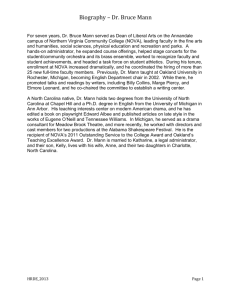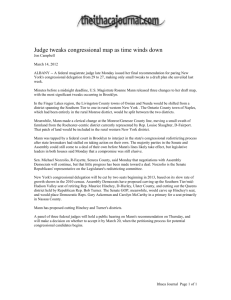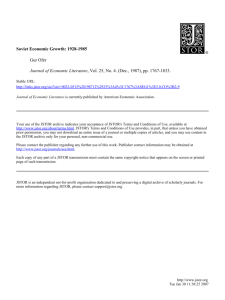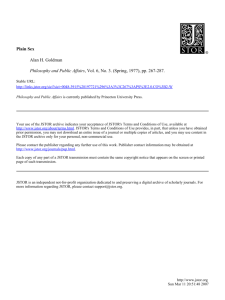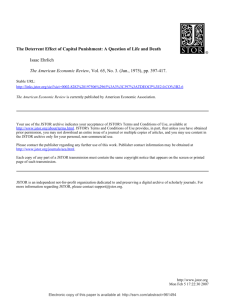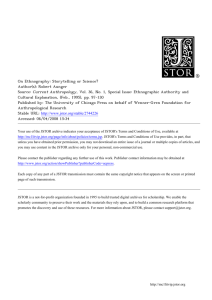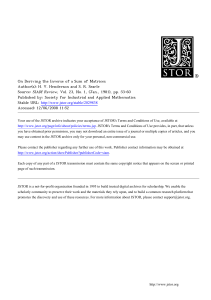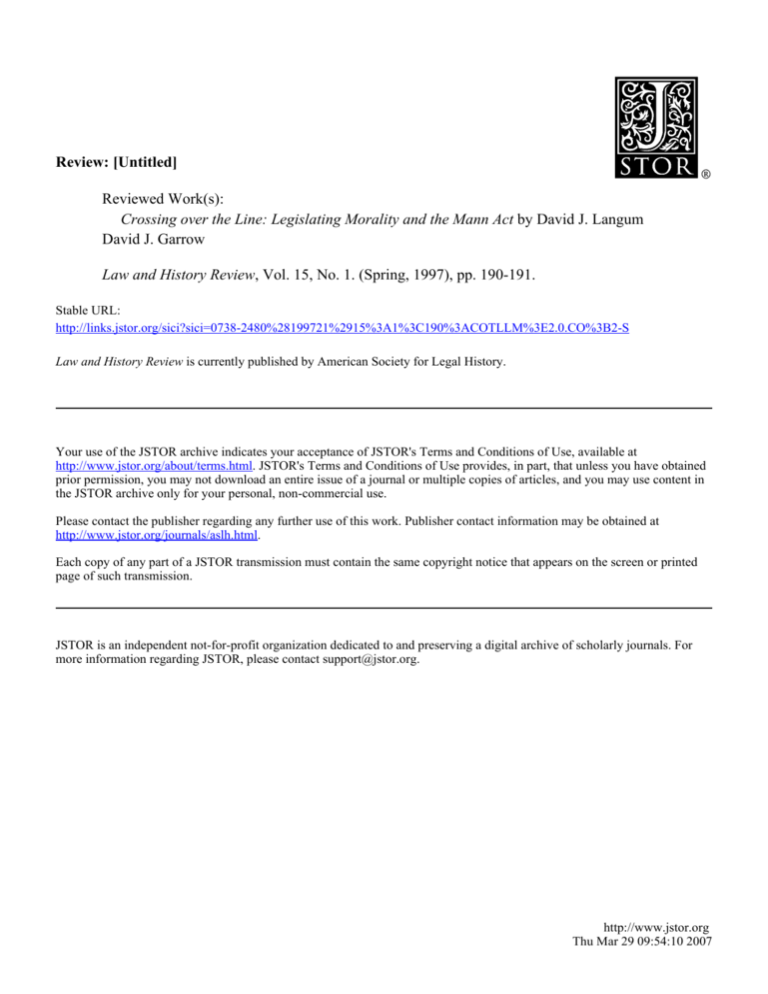
Review: [Untitled]
Reviewed Work(s):
Crossing over the Line: Legislating Morality and the Mann Act by David J. Langum
David J. Garrow
Law and History Review, Vol. 15, No. 1. (Spring, 1997), pp. 190-191.
Stable URL:
http://links.jstor.org/sici?sici=0738-2480%28199721%2915%3A1%3C190%3ACOTLLM%3E2.0.CO%3B2-S
Law and History Review is currently published by American Society for Legal History.
Your use of the JSTOR archive indicates your acceptance of JSTOR's Terms and Conditions of Use, available at
http://www.jstor.org/about/terms.html. JSTOR's Terms and Conditions of Use provides, in part, that unless you have obtained
prior permission, you may not download an entire issue of a journal or multiple copies of articles, and you may use content in
the JSTOR archive only for your personal, non-commercial use.
Please contact the publisher regarding any further use of this work. Publisher contact information may be obtained at
http://www.jstor.org/journals/aslh.html.
Each copy of any part of a JSTOR transmission must contain the same copyright notice that appears on the screen or printed
page of such transmission.
JSTOR is an independent not-for-profit organization dedicated to and preserving a digital archive of scholarly journals. For
more information regarding JSTOR, please contact support@jstor.org.
http://www.jstor.org
Thu Mar 29 09:54:10 2007
190
Law and History Review, Spring 1997
that of common law slave states. Was this true? Where does Louisiana fit, and what
relationship might there have been between "Americanization" of Louisiana's slave law
and racism? There are, of course, other questions as well, but Schafer has provided a
very solid base from which to proceed.
Thomas D. Morris
Portland State University
David J. Langum, Crossing over the Line: Legislating Morality and the Mann
Act, Chicago: University of Chicago Press, 1994. Pp. xii + 3 11. $24.95 (ISBN
0-226-46880- 1).
Langum's history of the creation and enforcement of the "White Slave Traffic Act of 1 9 1 0
is a creditable and competent account of a criminal statute whose sexual focus made its name
one of the better-known federal legislative appellations of the twentieth century. Thoroughly
researched and approachably written, Crossing over the Line repeatedly emphasizes how
the story of the Mann Act is in significant part a story of how overly inclusive statutory
language eventually led to prosecutorial applications and judicial readings that reached well
beyond the 1910 intentions of the law's drafters and congressional proponents.
Chicago Representative James R. Mann and other like-minded contemporaries who
wanted to stamp out the much-discussed (but little documented) phenomenon of forcibly coerced female prostitution won speedy congressional approval for provisions that
invoked the commerce power to make it a federal crime to aid in the interstate transport of any woman "for the purpose of prostitution or debauchery, or for any other
immoral purpose" (261). Their language, however, criminalized not only all interstate
transit that aided or abetted voluntary as well as coerced commercial prostitution but
also, through the vague proscription of "other" immoral purposes, opened the statutory door to the possible federal prosecution of unmarried couples whose friendly and
noncommercial interstate travels included or implied the practice of sexual relations.
Langum places primary blame on the federal courts, rather than on congressional drafters or Justice Department prosecutors, for the rather rapid expansion of Mann Act prosecutions to include "boyfriend-girlfriend travel" (1 1). But, particularly with regard to
the Justice Department's uncertain and ambivalent application of the law's open-ended language during the 1910s, Langum emphasizes that "the public actually pushed the
government to go farther in its interpretation and enforcement of the statute than government itself originally wanted to go" (11). Undergirding public sentiment, Langum
stresses, was a "repressive American puritanism, largely religiously inspired, [and]
opposed broadly to sexuality outside of marriage, that was at work" (7).
The expansive, puritanical application of the Mann Act was ratified by the Supreme
Court in 1917 in Caminetti v. United States. While Langum gives extensive attention
to the origins and prosecution of the Caminetti case (the original June 1913 trial in
Sacramento made the front page of the New York Times four times), he unfortunately
says far less than he might regarding two earlier and likewise significant Supreme Court
rulings in Hoke v. United States (1913) and Wilson v. United States (1914).
Langum believes that "beginning approximately in 1928 there was a curtailment of
- -
Book Reviews
191
prosecution for noncommercial offenses" ( 9 9 , occasioned both by increasing trial jury
opposition to such charges and by a more general liberalization in American attitudes
toward nonmarital sex. However, neither in the 1930s nor even in the 1960s was there
any legislative reform or repeal of the Mann Act's expansive provisions; a change in
public opinion was insufficient to generate congressional liberalization of the law's
invocation of now outdated standards of sexual morality.
Crossing over the Line's treatment of post-World War I1 Mann Act cases is sometimes unsatisfying, in part because of Langum's somewhat unclear assertion that the
"easy availability" of "trial records stops in the mid-1940s" (215), and perhaps in greater
part because of Langum's failure to submit FOIA (Freedom of Information Act) requests
to the FBI (whose early growth the Mann Act much aided) with the four- or five-year
lead time that experienced FOIA users now know is necessary for the processing and
release of most requests. Hence, at least one of Langum's conclusions-that "as a practical matter, the Mann Act is now limited to prostitution, forced sex, and perhaps the
creation of pornography" (252)-strikes an explicitly uncertain note at the very same
time that Langum confidently-and persuasively-is able to attribute that dramatic
change not to any formal modifications in the law but instead to how "the vast majority of the American public [now] is far more tolerant of extramarital sexuality than it
was in the early part of the century" (252).
Beyond citing the two extremely well known cases of fighter Jack Johnson and musician Chuck Berry, Langum does little to advance his argument that "the Mann Act
also became an instrument of racism" (254), and at times a more assertive editor could
have saved Langum from some rhetorical excesses. Dedicating Crossing over the Line
to "the victims of the Department of Justice" is perhaps appropriate, but when Langum says that "Then, as in our own day, self-righteous politicians and preachers blathered on about moral decay and degeneracy" (165), even the most sympathetic reader
cringes just a bit. When Langum further contends that "The federal use of strong-arm
tactics continues today and ought to be intolerable in a free society" (171), even the
most attentive reader may feel somewhat puzzled.
But by far the greatest weakness of Crossing over the Line is a contextual sin of
omission rather than commission: never once does the book even mention the name of
Anthony Comstock, the well-known anti-vice and anti-obscenity crusader whose efforts were heavily publicized in the years prior to 1910 and whose personal and organizational efforts continued well into the 1910s. Likewise, never once does Crossing
over the Line even mention birth control advocate Margaret Sanger or similar activists
whose efforts during the 1910s and 1920s represented a highly visible challenge to
conservative sexual norms, nor does Crossing over ever discuss or allude to how many
state and local criminal prosecutions of Sanger and other birth control advocates were
launched during the very same years when federal agents were so energetically and
expansively enforcing the anti-sex provisions of the Mann Act. Had David Langum
made a greater and more inclusive effort to paint the sexual dimensions of criminal law
and public policy struggles during those two fascinating decades. Crossing over the Line
might well have been a far more insightful and provocative volume.
David J. Garrow
Emory University School of Law


